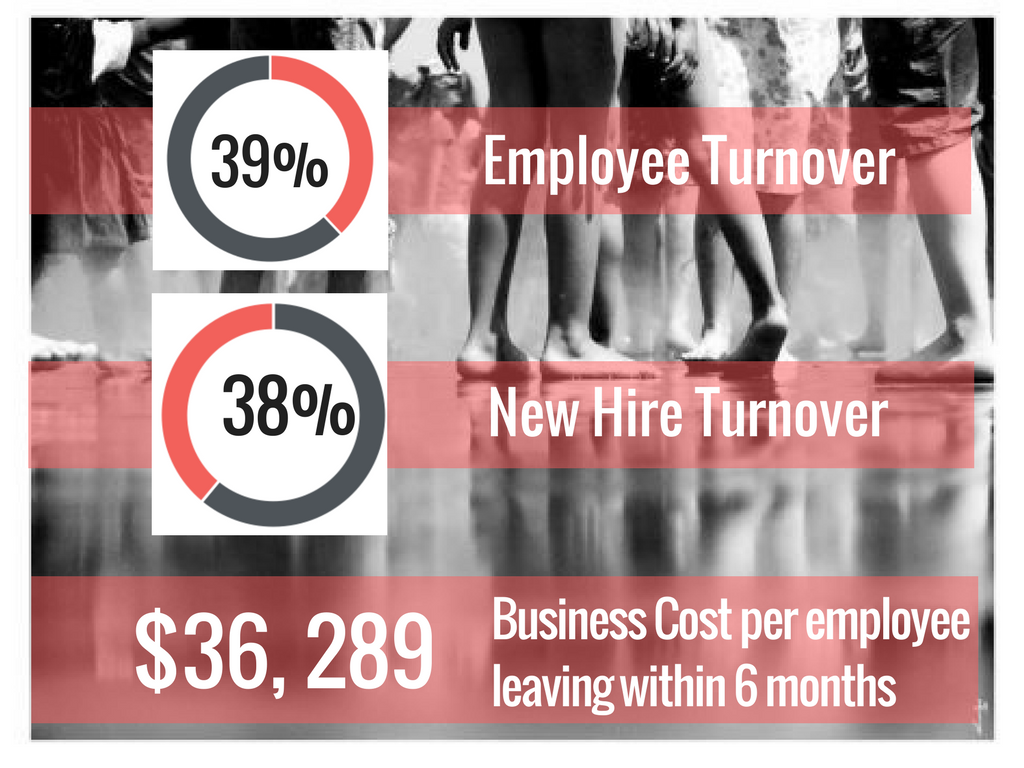
Hiring mistakes are bad news. They rattle employees, culture, customers and shake the bottom line.
But we accept this as business-as-usual, rarely measuring turnover and therefore it’s left unchecked.
Is it because the costs are buried mostly in salary and wages and training costs, in other words, sunk costs? But we wouldn’t accept faulty equipment or goods so why are we content letting hiring teams operate below par?
Here’s a case study of a business, a car dealership in Victoria that tackled this issue head-on.
Over a 8 month period staff turnover reduced by 9% from 39% to 30%. An overall 23% reduction in the turnover rate.
A small Human Resources team in a mid- sized car dealership was overwhelmed by the constant hiring and on-boarding of people, of up to 5 roles every month. Unfortunately these vacancies bore from turnover not business expansion. More concerning was the fact they were readvertising for roles they’d only filled months earlier.
They collected data and were surprised to find the following results.

“We were too short-term focused. Putting bums on seats so we didn’t miss out on sales. But instead we found that our costs were disproportionately larger.” Sharon Pask, CFO, Frankston Toyota.
The recruitment process was broken, that was obvious. What to do about it wasn’t so clear.
At the same time this dealership was also looking to tackle it’s male dominated workforce by recruiting more women to better serve it’s female dominated customer base. The key was to remove bias from the recruitment process and instead focus on merit.
There are a number of best practices when it comes to removing bias from the recruitment process ranging from anonymising candidates identity, using work skills questions to better screen candidates to deploying a structured interviewing process.
What quickly became obvious was that once you remove bias from the recruitment process the odds of finding the best person, male or female, for the job increases significantly.
How to achieve this was the next hurdle. To actually remove bias from the process can be time consuming if done manually. Instead the team found software that could do this for them.
“We didn’t have the time or resources to achieve a ‘gold standard’ recruitment process that removes bias. Technology has been a real enabler. We now have a recruitment process that helps everyone involved in hiring make much more educated and better hiring decisions.” Amanda Heveren, Human Resources, Frankston Toyota
Here’s how the software fixed the recruitment process and the significant impact it’s had.
- The business no longer makes snap judgements about which candidates will and won’t fit in. No more ‘gut feel’ judgements.
The software generates work sample questions that candidates answer online, to assess how well they can perform the daily activities and tasks required of the role. This is the most reliable way to predict how well a candidate will perform on the job. In addition the software anonymises candidate personal details to prevent hiring teams from making snap judgements about whose likely to fit in. When it comes to the interview stage the system forces hiring teams to adopt a structured interview process and dispense with the informal process that’s the norm. This means establishing pre-set interview questions, asked of each candidate in the same order with each question scored immediately. The business hadn’t realised that they were hiring certain types, over again. For example sales consultants have traditionally been white males with previous automotive selling. Now they’re seriously considering females, even people outside the automotive industry and seeing some early great results.
- The business now offers a superior candidate experience, with less interview no shows and greater offer acceptance.
Before implementing the online recruitment application, keeping candidates informed about the progress of their application was a time consuming task and sometimes didn’t get the priority it deserved. The online recruitment application automatically generates rejection emails, which is such a time saver. Businesses are encouraged to provide company details and employee benefits along with the job description, right when it counts, during the application phase. Candidates value this information and rate companies higher as a result. This business has had less interview no shows and feels this will ultimate improve their reputation as a great place to work and thus their ability to attract talent.
- The screening process self selects those candidates who are most genuine about the role and the company.
An unexpected outcome of using the recruitment application was the significant candidate drop off when asked to complete the online assessment. Based on some internal research which involved calling the non-completers the business found these were in fact non-genuine applicants. The ability to develop a simple careers page which conveys valuable information about your company, the role, along with work sample questions provides candidates with a clear picture of the job and how well matched they think they are. Not having to process non-genuine candidates has saved the business time and money.
“On average the screening knocks out about half of the candidates who apply to the job, as people click on the link and abandon it once they are a few questions in. Some people did not even attempt to click on the link. This automatically started the screening process removing candidates who clearly were not passionate about wanting to work for our organisation”. Sharon Pask, CFO, Frankston Toyota
- Saves enormous amount of time sifting through applications when there are hundreds of candidates to screen.
For some roles eg administrative and customer service roles the business receives more than 200 applicants which in the past has been so time consuming. The process is much more streamlined using the online recruitment application because it automatically identifies the most qualified and suitable applicants, without bias.
“The system certainly bubbled the cream to the top of the pile” Sharon Pask, CFO, Frankston Toyota
- Engages the hiring team to seek ways to improve the recruitment process
Implementing the online recruitment application has encouraged the hiring teams to rethink their hiring processes. For example, collaborating on what it takes to be a top candidate, what questions to ask, what responses are most valued and active participation by hiring managers in the evaluation process instead of defecting many hiring tasks to the HR team. The positive benefits for this business also had spin off for the on-boarding process where the HR Manager now spends time with every new employee in their first week and at the two month anniversary to ensure they are settling in.
- Access to reports that helps understand candidate profiles during the recruitment process and what’s working and doesn’t work
The online recruitment application generates useful reports including candidate demographics. This business is still very motivated to increase the number of female recruits and armed with these reports they’ve found that females are applying but not getting through the initial screening. They are now examining if this is because of the quality of the female applicants or whether the essential role requirements are too rigid.
- Provides a recruitment workflow that streamlines the process so you can remove steps that are not value adding.
Like many business processes, the recruitment process can experience creep, where new steps are introduced in the hope that it will improve outcomes. The online recruitment application reflects best practice recruitment so bolting on additional steps are simply costing money and time. All this does is make you less competitive to attract top talent. By centralising the recruitment function you can better manage it’s costs and outcomes.
[postoptin headline=”Your Recruiting Fix” text=”Subscribe to our regular newsletter” cta=”Sign Up” animate=”no”]
